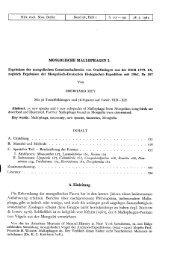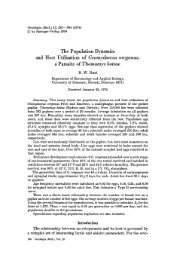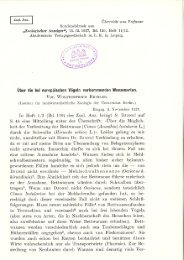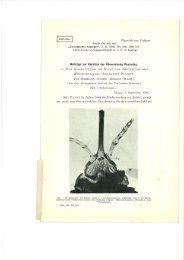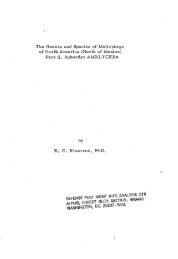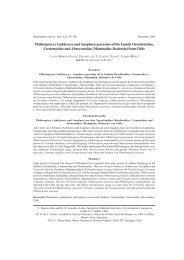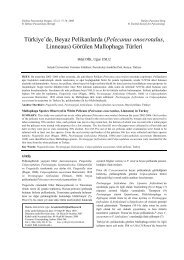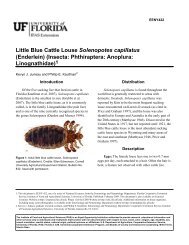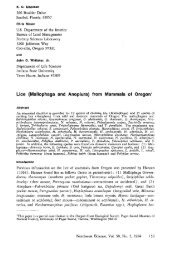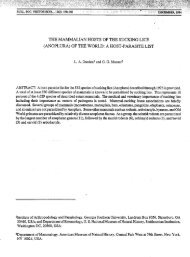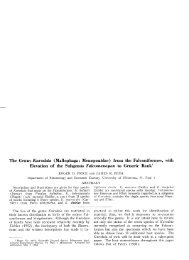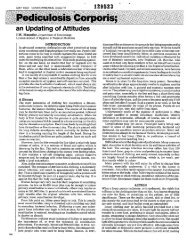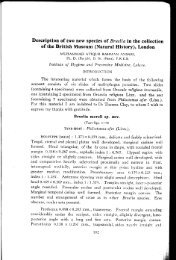The Geographical and Ecological Distribution of Arboreal Psocoptera
The Geographical and Ecological Distribution of Arboreal Psocoptera
The Geographical and Ecological Distribution of Arboreal Psocoptera
You also want an ePaper? Increase the reach of your titles
YUMPU automatically turns print PDFs into web optimized ePapers that Google loves.
Annu. Rev. Entomol. 1985.30:175-196. Downloaded from arjournals.annualreviews.org<br />
by Mr. Bas van Berkum on 10/10/07. For personal use only.<br />
Annual Reviews<br />
www.annualreviews.org/aronline<br />
182 THORNTON<br />
seven cases <strong>of</strong> species pairs with a member <strong>of</strong> each occurring in Africa <strong>and</strong><br />
Madagascar; other species pairs appear to represent a more recent disjunction<br />
within Madagascar itself.<br />
<strong>The</strong> Mascarene Isl<strong>and</strong>s, Reunion <strong>and</strong> Mauritius, together have a fauna <strong>of</strong> 44<br />
species, half <strong>of</strong> which is endemic to the group. <strong>The</strong> isl<strong>and</strong>s have know faunas <strong>of</strong><br />
34 (12 endemic) <strong>and</strong> 16 (6 endemic) species respectively, with 6 species<br />
common (4 endemic) (2, 10, 94). Three genera endemic--lsophanopsis<br />
(Caeciliidae) on Reunion <strong>and</strong> Mockfordiella (Caeciliidae) <strong>and</strong> Mascaropsocus<br />
(Peripsocidae) on both isl<strong>and</strong>s. <strong>The</strong> fauna has remarkably little affinity with<br />
that <strong>of</strong> Madagascar. For example, the relationships <strong>of</strong> the Reunion endemics<br />
with Madagascar are few <strong>and</strong> probably represent very old phylogenetic events;<br />
present conditions are unfavorable for faunal exchange.<br />
North America <strong>and</strong> the Neotropics<br />
About a score <strong>of</strong> North American species have Holarctic distributions. Some<br />
may be true relicts, but about half are probably the result <strong>of</strong> recent introductions<br />
(49, 50).<br />
Lachesilla, one <strong>of</strong> the largest genera in the order with almost 300 recognized<br />
species (27; A. N. Garcia-Aldrete personal communication), has its chief<br />
representation in North America (over 120 species endemic). Of the 18 species<br />
groups recognized, all are represented in the Americas <strong>and</strong> all but two in North<br />
<strong>and</strong> Central America. Only three groups extend beyond the New World to<br />
Africa (all), Europe (one), <strong>and</strong> Madagascar (one).<br />
Systematic studies <strong>of</strong> the cerastipsocine Psocidae suggest an early New<br />
World radiation with African <strong>and</strong> Oriental groups as derivatives (51).<br />
example <strong>of</strong> a monophyletic group confined to Central <strong>and</strong> North America is<br />
Kaestneriella (Peripsocidae) (56).<br />
Recent work on the North American fauna has concentrated on detailed<br />
continental distributions <strong>of</strong> species (25), species pairs (48), <strong>and</strong> species groups<br />
(14, 40, 41, 43-45, 53). Many <strong>of</strong> these distributions may be related to the<br />
effects <strong>of</strong> glacial changes (disruptions <strong>of</strong> previously continuous ranges, Pleistocene<br />
refugia, <strong>and</strong> early Tertiary invasions from the south).<br />
In view <strong>of</strong> the massive representation <strong>of</strong> Lachesilla on the continent it is<br />
remarkable that only four species occur in Cuba, only one <strong>of</strong> which is unknown<br />
elsewhere. Of the 68 psocids known from Cuba (8, 46), 35 (51%) are presumed<br />
endemics. About half have close relatives in the Caribbean area or the adjacent<br />
mainl<strong>and</strong>, <strong>and</strong> in the Psocidae the genera Blaste <strong>and</strong> Indiopsocus have closely<br />
related groups <strong>of</strong> species that are probably autochthonous. <strong>The</strong>re is no endemic<br />
genus. Most <strong>of</strong> the widespread tropical species occur also in Africa <strong>and</strong> were<br />
possibly introduced to the American tropics during the slave trade.<br />
Jamaica has also been surveyed (93), <strong>and</strong> 83 species are known./kgain, there



